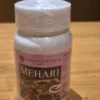Bhumyamalaki
|
Botanical Name |
Phullanthus Niruri |
|
Family |
Euphorbiaceae |
|
Sanskrit: |
Bhoodharthi, Adhyanda, Ajatha |
|
English |
|
|
Hindi |
Hazarmani, Lalbhuinanvalah |
|
Kannada |
Kempu Kiranelli |
|
Malayalam |
Kizharnelli |
|
Telugu |
Erra Usirika |
|
Tamil |
Shivappunelli |
|
Marathi |
Bhuiavala |
Distribution:
It is a native to tropical east asia and is a weed to tropical areas. It is commonly found in open areas.
|
Parts Used: |
Panchaanga |
|
Dose: |
Swarasa: 10-15ml, Churna : 3-5gm |
Chemical Constituents
Nirphyllin, phyllnirurin, corilagin, ellagic acid, gallic acid etc
Ayurvedic Properties:
|
Quality (Guna) |
Laghu, Ruksha |
|
Taste (Rasa) |
Tikta, Kashaya, Madhura |
|
Metabolism (Vipaka) |
Madhura |
|
Potency (Virya) |
Sheeta |
|
Impact (Prabhava) |
Mutra-Virechaniya |
Pharmacological Action:
- It is a diuretic and thus helpful in urinary tract disorders.
- It is helpful in diarrhea.
- Its hypogycaemic properties helps in lowering blood sugar level in the body.
- It is a good appetizer and helps in improving digestive problems.
- It has anticancerous property helping in curing cancer.
- It is hepatoprotective and thus cures liver disorders and certain metabolic disorders
Therapeutic Uses
- Leucorrhea: bhumyamalaki powder must be taken along with rice water in gynecological disorders.
- Paste of its leaves is applied on wounds, edema and dermatitis.
- Fractures: its leaves is crushed with rock salt and is applied over the fracture region.
- Powder of leaves and roots is made as poultice along with rice water over edematous swelling.
Some of the common formulations
- Bhumyamalaki Churna
- Amritaprasha Ghrita Etc




